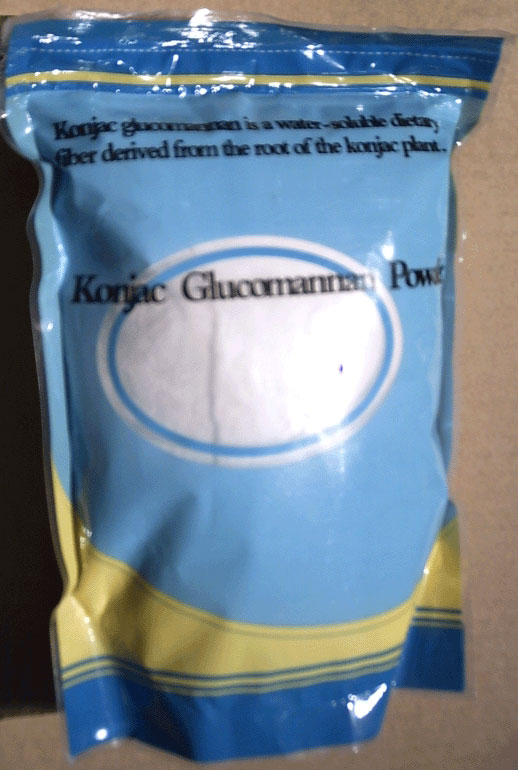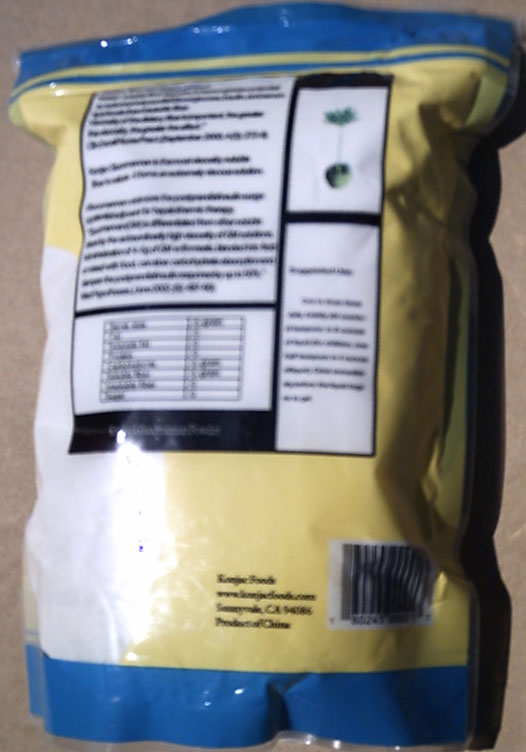|
Konjac Glucomannan Powder (Konjac Root Fiber):
500g/bag
Nutrition Fact
Servings per container: 100
|
Serving
size(Teaspoon)
|
5g
|
|
Fat
|
0
|
|
Protein
|
0
|
|
Carbohydrated
|
5g
|
|
Soluble
fiber
|
5g
|
|
Insoluble
fiber
|
0
|
|
Sugar
|
0
|
 
Konjac glucomanan powder is pure soluble fiber, none protein,
none fat, none sugar, none starch, it is also gluten free
and wheat free.
Order Online $19.00
per bag plus $5.00 shipping fee with post office priority mail.
Konjac glucomanan powder certificate of analysis report
|
Appearance
|
White powder
|
|
Glucomannan(Dried)
|
>90% |
|
Viscosity(1% Solution)
|
>35000 mpas
|
|
PH level of 1%
|
7
|
|
Moisture %
|
<10.5 %
|
|
Ash content %
|
<0.5 mg/kg
|
|
Lead mg/kg
|
<0.3 mg/kg
|
|
Arsenics mg/kg
|
<0.1 mg/kg
|
|
Free SO2 g/kg
|
<0.3 g/kg
|
|
TPO /g
|
<1000 /g
|
|
Particle size mesh
|
120 mesh
|
How to use Konjac Glucomannan Powder:
Drink it with water:
Three times daily before each meal, briskly stir one level
teasponn konjac powder (about 4 gram) in 8 ounces of water, drink
immediatly before the begins to gel.
Use it as thickener
The most popular food thickener is the starch type thickener,
such as cornstarch. Konjac glucomannan is a natural, odorless
soluble fiber that is found in the konjac plant. The konjac glucomanan
is the most viscosity food gum in nature. It has about ten times
the viscosity than the cornstarch. Konjac glucomannan is also
called konjac flour or konjac gum. Unlike the cornstarch, the
konjac powder is the soluble fiber, which does not contain starch
and sugar, it does not have calories.
Konjac flour can be used as a thickening agent in food application.
When using konjac flour for thickening, always mix it with a small
amount of liquid (cold water, stock, wine, etc.) till smooth,
then add this mixture to the food that you want thickened. If
you add konjac powder directly to your food you will end up with
a lumpy mess. Konjac powder can be used as a thickener for smooth
gravies, sauces, glazes, soups, stews and casseroles. It is also
a thickener in pies, puddings, custards and cake fillings. This
naturally odorless, vegetable powder is also gluten-free, making
it the perfect substitute in cooking and baking when flour and
other glutinous starches must be avoided.
Konjac powder doesn't thicken very much when mixed with cold
water, but quickly thickens when it's heated. This is why you
don't add dry konjac powder directly to hot liquids. It will seize
and immediately turn into lumps because the konjac powder that
contacts the water so quickly and fully absorbs the liquid before
the adjacent konjac powder can. Mixing konjac powder with cold
water allows it to absorb the water slow enough that it's easily
and fully dissolved first. The dissolved konjac powder can then
be added to a hot liquid to absorb it without lumping.
Konjac powder is an ingredient to thicken sauces and gravies
or any other cooked recipe. To use konjac powder as a thickening
agent, first disperse it in a little cold water or other "watery"
ingredients such as soy sauce, and slowly add it (with constant
stirring) to the other ingredients while they are cooking. About
1 teaspoon of konjac powder will gel about one cup of liquid.
If you have not used konjac powder as a thickening agent before,
it is best to experiment with it by beginning with lesser amounts,
and adding as necessary until the desired consistency is reached.
Konjac powder has about ten times the thickening power of cornstarch.
Dissolve the konjac powder in a little cold water before adding
it to the sauce. Konjac flour thickens nicely when it's heated
to boiling temperature, so it usually works well for savory sauces.
You could also use a konjac powder to thicken your broth - konjac
powder is a very powerful thickener and does not add much taste
Soluble Fiber Intake & Type 2 Diabetes Mellitus:
The Research
Research proves that the higher the viscosity of soluble
fiber, the better the control of blood sugar level in patients
with Type 2 diabetes.
The konjac glucomanann is the most viscosity soluble fiber in
the nature.
According the medical research, Clinical Excellence for Nurse
Practitioners. 2000 Sep;4(5):272-6
Dietary fiber and type 2 diabetes
"Water-soluble fiber appears to have a greater potential to reduce
postprandial blood glucose, insulin, and serum lipid levels than
insoluble fiber. Viscosity of the dietary fiber is important;
the greater the viscosity, the greater the effect."
The
New England Journal of Medicine (May 11, 2000. v342: 1392-1398)
Beneficial effects of high dietary fiber intake in patients
with type 2 diabetes mellitus.
"A high intake of dietary fiber, particularly of the
soluble type, above the level recommended by the ADA, improves
glycemic control, decreases hyperinsulinemia, and lowers plasma
lipid concentrations in patients with type 2 diabetes"
Med
Hypotheses. (June 2002; (6): 487-90)
Glucomannan minimizes the postprandial insulin surge: a potential
adjuvant for hepatothermic therapy.
"Glucomannan (GM) is differentiated from other soluble fibers
by the extraordinarily high viscosity of GM solutions. Administration
of 4-5g of GM with meals, blended into fluid or mixed with food,
can slow carbohydrate absorption and dampen the postprandial insulin
response by up to 50%. "
Diabetes
Care (1999 Jun v22, i6; 913-919)
Konjac-mannan (glucomannan) improves glycemia and other associated
risk factors for coronary heart disease in type 2 diabetes. A
randomized controlled metabolic trial.
"KJM fiber added to conventional treatment may ameliorate
glycemic control, blood lipid profile, and SBP in high-risk diabetic
individuals, possibly improving the effectiveness of conventional
treatment in type 2 diabetes"
Diabetes
Care (2000; 23: 9 - 14)
Beneficial effects of viscous dietary fiber from Konjac-mannan
in subjects with the insulin resistance syndrome: results of a
controlled metabolic trial.
"A diet rich in high-viscosity KJM improves glycemic control
and lipid profile, suggesting a therapeutic potential in the treatment
of the insulin resistance syndrome."
Journal
of the American College of Nutrition (2003, February, 22(1): 36-42)
Konjac supplement alleviated hypercholesterolemia and hyperglycemia
in type 2 diabetic subjects--a randomized double-blind trial.
"The KGM supplement improved blood lipid levels by enhancing
fecal excretion of neutral sterol and bile acid and alleviated
the elevated glucose levels in diabetic subjects. KGM could be
an adjunct for the treatment of hyperlipidemic diabetic subjects."
Customer Testimonials
Before using the Konjac Glucomannan (KGM) powder, my daily Blood
Glucose average was over 155. The second day after I started using
the powder (1/2 teaspoon, 3 times a day), my daily average was
125. I am now using 1 teaspoon 3 times a day and it is now averaging
under 110. I also reduced my medication by 1/2 and may discontinue
it completely. I'm happy and my doctors happy. Thanks again. Bill
Brandt
I received my konjac glucomannan powder last week. Since then,
I've been using it as extra fiber and also as a thickener in low
carb diet recipes. A little goes a long way - it only took a 1/2
teaspoon to thicken a sauce for an entire dinner. Joy
I have used both Konjac and guar gum to thicken sauce. Even though
they both work well, it is difficult to get the right consistency
with guar gum. Konjac is easier to work with. Marselle
I used Konjac "flour" to thicken my turkey gravy for
thanksgiving and it worked wonderfully. A little bit thickens
a lot. It behaves similar to cornstarch, except that it thickens
up cold - no heating, stirring, or waiting for it to thicken.
Marla
Last night, I used the glucomannan powder for the first time.
I am very impressed! I normally use xanthan gum as a thickener,
but I don't like the taste. The glucomannan has a neutral taste
and it isn't slimy like the xanthan gum. I am looking forward
to experimenting with it. Lana
Diabetes
Update By Daivd Mendosa Number 70; May 1, 2004
|